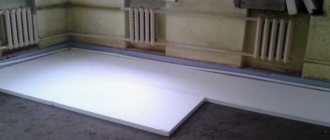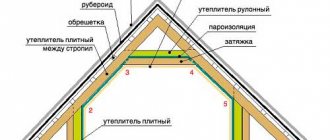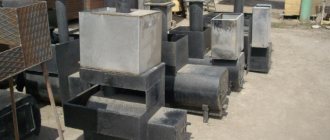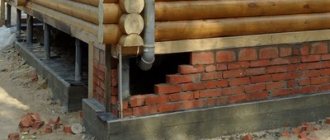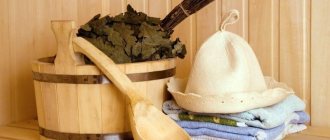Traditionally, in the wooden construction of bathhouses or residential buildings, inter-crown insulation is used to seal the joints in the walls.
The main purpose of the material is to insulate the log structure and improve the performance characteristics of the wood.
Most insulation materials contain natural components, however, some materials may contain artificial filling, which is absolutely not suitable for wooden buildings.
Why is insulation needed?
Inter-crown insulation is a universal material, therefore it is widely used for houses and baths made of rounded logs, profiled or laminated timber. In this case, the density of the insulation can be about 750 g/sq.m. with a thickness of up to 11 mm.
To reduce heat loss, the insulation is laid in one layer. It is important to remember that when using uneven or under-dried timber, the insulation is laid in several layers.
Insulation promotes timely vapor and heat insulation of wooden structures and high-quality air exchange in rooms.
When building a log bathhouse or house, an important condition is to minimize possible gaps between logs and beams. It is for this reason that work is being done to seal it with high-quality insulation.
Such measures are aimed at effectively protecting the building from adverse climatic conditions.
Jute tow
Jute tow is 100% made from jute. On the one hand, this is its significant plus, on the other hand, it is a minus that can become a problem when working with insulation. The fact is that jute tow itself is very rigid, which complicates the process of laying it on the work surface. It is for this reason that jute tow can most often be found with some additions of flax, which softens the insulation.
On the other hand, jute tow is most often produced in the form of rolls (tape), the thickness of which is ideally selected. It is for this reason that the tape is easy to install, and during its installation we will not have problems with level differences in a certain inter-crown crown of a wooden house. In turn, when choosing the width of the tape, we can take a larger value, which will allow us to place it with a slight overlap inside and outside the bath. This will be useful to us at that moment in time when the wooden structure shrinks.
Note that jute itself is not afraid of moisture. In addition, jute tow is an example of secondary production, which makes its cost very low and even budget-friendly. That is why any owner of a wooden bathhouse in our country can afford to use jute tow.
Advantages of jute as inter-crown insulation for a bath:
- the composition of jute is very close in composition to wood - logs, timber, lumber;
- environmental purity of natural jute;
- good thermal protection performance;
- durability.
Performance characteristics
High-quality insulation, which is laid between the crowns of logs or beams, must meet high standards of quality and safety of use. Therefore, the main performance characteristics of the material include:
- High elasticity and density, maintaining properties throughout the entire period of operation. Thanks to its elasticity, the insulation is able to take the desired shape, and its density is able to fill existing gaps between the crowns.
- Low thermal conductivity for effective protection of walls from heat loss.
- High moisture and vapor permeability.
- Resistance to mold, fungi and harmful microorganisms that arise when exposed to increased moisture and heat.
- Resistant to ultraviolet exposure and adverse weather conditions.
What is jute
Jute is made into a durable textile fiber. Russian consumers are familiar with this material - bags for transporting rice, coffee, and sugar are made from it. They do not allow moisture to pass through, which is especially important when transporting products over long distances. Such packaging is gradually replacing plastic packaging as more environmentally friendly.
Jute is used in the production of ropes, bags, canvases for painting, decorative boxes, and furniture containers. Its properties:
- high hygroscopicity;
- strength;
- resistance to deformation;
- good breathability;
- thermal insulation;
- environmental friendliness;
- affordable price.
Thanks to these qualities, the material is also used in the construction industry - it is ideal as insulation for the construction of wooden buildings. Jute for a bath is a win-win option.
Types of interventional insulation
The modern construction market offers a large selection of natural insulation materials.
The most common options are felt, jute, moss, linen and combined.
Manufacturers also offer wear-resistant synthetic insulating materials - penofol, mineral wool, polystyrene foam boards, silicone sealants.
Without a doubt, they have higher performance characteristics in comparison with natural analogues, but they are not suitable for insulating wooden buildings.
Felt (sheep's wool)
A natural material for insulation, which in its performance properties is superior to tape insulation made from plant fibers.
Felt is a worthy option for buildings made of profiled timber. It is simply irreplaceable for insulating residential buildings and baths, although it is not cheap.
During the production process, the felt seal is carefully treated with special fire-retardant compounds, as a result of which it absorbs moisture well and quickly releases it when heated.
It is resistant to mold and mildew and does not cake during use.
Felt is suitable for insulating walls and partitions of log houses and bathhouses.
Jute
Jute material is a modern representative of tape insulation, which has a dense and uniform structure. Jute is an expensive material, unlike flax, but it is of higher quality.
A distinctive characteristic of jute is its high hygroscopicity.
Jute inter-crown insulation is made from annual tropical plants of the mallow family, which grow in hot countries. Plants contain about 25% lingin - a natural resin that has high antiseptic properties.
Jute has a lot of advantages that set it apart from its main competitors:
- Environmental friendliness and safety;
- Good thermal conductivity;
- Resistance to rotting and fungal attack;
- Durability and practicality;
- Easy installation;
- Attractive appearance.
Disadvantages include susceptibility to caking and high cost.
Walls insulated with jute tape do not require additional decorative finishing, and the seams are smooth and tight.
Jute is represented by the following varieties: jute tow, jute felt and jute flax.
- Tow has solid and long fibers. Used for caulking seams.
- Felt is characterized by increased fragility and stiffness of the fibers. Used to seal door and window openings.
- Jute flax is a mixture of flax and jute fibers. It is characterized by high wear resistance and elasticity. Suitable for caulking walls and partitions.
Moss
Currently, moss remains an accessible and cheap option for insulating crowns in houses and bathhouses made of logs or timber. Moss is a natural thermal insulation material that has unique performance characteristics:
- Environmentally friendly;
- Vapor tightness;
- Resistant to creasing and deformation;
- Antiseptic properties.
Moss quickly absorbs excess moisture and provides good air exchange. It is recommended to use sphagnum (white moss) and cuckoo flax (red moss) as inter-crown insulation.
The most durable and wear-resistant is red moss, which is characterized by a high content of antiseptic components and resistance to high moisture.
White moss has high thermal insulation properties and reliably protects wood from fungal infections.
Despite the obvious advantages, moss also has some disadvantages - low fire resistance and difficulty in installation.
Linen
Linen materials for insulation have been used for quite a long time. Linen is hypoallergenic, provides good air exchange, does not create static charges, and is resistant to mold on the walls. Interventional insulation of this type has:
- High elasticity and softness of fibers;
- Long service life;
- Low thermal conductivity coefficient;
- Resistant to UV radiation, microorganisms and mold;
- Affordable price.
Currently, manufacturers offer two types of linen insulation - tow and flax wool.
Tow
It is characterized by low cost and complexity of installation. Inter-crown insulation for timber is highly hygroscopic and prone to rotting, so it is more advisable to use it to seal window and door openings.
When using tow, caulking is carried out twice - in the first year after construction is completed, and in the second year - after the building has settled.
Lnovatin
A material that is made from flax fibers using special equipment.
To give strength, the finished fabric is stitched with threads. Linen batting is affordable and easy to install. This is a good economical option that is suitable for insulating houses and baths.
Often used after complete shrinkage of the structure.
Combined insulation materials
This category includes natural-based insulation without the use of synthetic fibers.
They have unique performance properties of the material from which they are made.
Flax in combined materials increases elasticity and practicality, jute increases resistance to creasing and caking.
The special structure of combined insulation materials satisfies the needs of the building material, taking into account the climatic conditions in which it is used.
What to choose
Since ancient times, natural and durable material – wood – has been used to build a real Russian bathhouse.
However, many years of experience show that it is impossible to achieve an ideal joint of materials either in manual cutting or in production, and this entails heat loss directly through the walls.
In this regard, even at the first stages of construction, each of the rows is laid with inter-crown insulation.
This allows you to completely eliminate heat loss through cracks in the walls.
Today, the most popular materials used as inter-crown insulation for baths are:
- Linen;
- Moss;
- Jute;
- Other insulation materials.
Let's look at each of the categories in more detail.
Important! All internal components of the wood structure must be dry and properly treated with antiseptics.
Linen
This material has been used since ancient times. Nowadays more modern insulation materials are produced, such as flax wool or tow.
Linen batting is a tape consisting of flax fibers.
Its advantages include:
- Long service life;
- Low hygroscopicity;
- Low price;
- Softness and elasticity;
- Excellent thermal insulation characteristics;
- Eco-friendly and natural.
Tow is also made in the form of a ribbon. It can be used in any type of log house, thanks to its not very dense structure.
Moss
Material such as moss was used to insulate the very first baths in Rus'.
It has been used for several centuries and is still used today.
The benefits of moss include:
- Bactericidal properties;
- Environmental friendliness;
- Good thermal insulation properties;
- Gas and vapor tightness;
- Moss also helps moisture-soaked wood dry out quickly.
White moss, otherwise known as sphagnum moss, is easily available because it grows everywhere.
Despite the fact that red moss is superior to sphagnum moss in most respects, builders most often use white moss.
This is explained by its availability.
Important! For repair and construction purposes, only two types of moss are used - white and red.
Sphagnum has a smaller amount of bactericidal substances, it retains heat well, but deteriorates quite quickly.
In turn, red moss (or cuckoo flax) has a number of advantages:
- It is durable and resilient;
- It contains substances that prevent premature destruction, rotting and the appearance of fungi;
- Due to the length of red moss, it is much easier to install;
- Low moisture capacity;
- Long service life.
Jute
This material is becoming increasingly popular, especially in urban areas.
Insulating jute is produced by processing an annual plant of the same name.
Its advantages:
- Excellent thermal insulation characteristics;
- Ease of installation;
- The color is close to wood, so it does not spoil the design of the building;
- Environmental friendliness;
- Durability;
- It contains lignin, which prevents rotting of both the insulating layer and the building structure itself.
The disadvantages include the fact that jute cakes over time, and its use in log houses is limited. In addition, the cost of jute is quite high.
There are several varieties of this product:
- Flax-jute;
- Jute tow;
- Jute felt.
Flax-jute and jute felt are produced in the form of a tape, which is why it is better not to use them in regular log houses. But they are perfect for baths made of profiled and regular timber, as well as rounded logs.
Other options
In addition to the above insulation materials, others, less popular for wooden structures, are periodically used:
- Thermally insulated tapes. They have excellent heat-insulating and moisture-repellent properties, but significantly spoil the microclimate of the room;
- It is better not to use synthetic and mineral insulation, as well as padding polyester, batting and sealants for a Russian bath;
- Fiber from wool. It insulates well, but the cost is quite high.
So which interventional insulation is best for a bathhouse?
There is no definite answer to this question, but one thing can be said - when building a traditional Russian bathhouse from natural materials, it is best to use natural insulation:
- Insulation for hand-cut sauna logs is linen tow and moss;
- How to insulate a bathhouse made from timber from the outside? – Penoplex, mineral wool.
What insulation is suitable for a bath?
Beginners often ask themselves the question: what insulation to choose for the walls of a bathhouse?
For a bathhouse, it is recommended to use inter-crown insulation for timber made of natural fibers. This seal does not accumulate moisture, provides good air exchange, and is resistant to rotting and destruction.
The best representatives are insulation materials made of moss, jute and flax, as well as their derivatives. They are successfully used for caulking wooden houses and baths.
To understand which is the best insulation for a bathhouse, you should pay attention to the main characteristic of the material – density.
For timber structures, insulation with a thickness of 4 mm and a density of 350–450 g/sq.m. is used.
For steam rooms made from rounded logs, products with a thickness of 5 mm and a density of at least 600 g/sq.m. are better suited.
For houses with 2–3 floors combined with a bathhouse, material with a thickness of 9–11 mm and a density of up to 750 g/sq.m is used.
To choose a quality sealant, you need to know what type of wood is used to build the log house.
For bathhouses made of timber and rounded logs, you can choose materials up to 10 mm thick - jute felt, flax felt, a combined version with jute and flax.
For a chopped-type bathhouse, it is better to choose insulation up to 15 mm thick - felt made of jute and flax, tow in ribbons and bales made of flax or jute, moss.
The main thermal insulators used: pros and cons
The origin of the word “caulk” is associated with hemp, from which hemp and twine for sealing cracks were made hundreds of years ago. Products based on this plant are still produced in separate nonwoven fabric factories. But sphagnum moss and “cuckoo flax”, which were once the most popular sealants in Russian wooden architecture, are now perceived as exotic. We will limit ourselves to considering what is present on the shelves of construction supermarkets and specialty stores.
Rolled flax insulation
Inter-crown linen seal
This inter-crown insulation is made from flax fibers using needle-punched technology. We can order any strip width from 3 to 40 cm in 0.5 cm increments. The thickness at a density of 700 g/m² is 8 - 10 mm.
Linen wool (as this thermal insulator is also called) is one of the best means for residual elasticity, heat conservation, environmental friendliness, and aesthetic properties. In addition, flax fiber tape is currently the most inexpensive way to efficiently caulk a chopped bathhouse. Rolled flax is easy to use. The strip is laid in the groove of the crown and adjusted with staples. The log can then be mounted. Wind is not a hindrance to installation.
Among the disadvantages of flax, it is not the best biostability. Birds happily take it out of the cracks to build nests. Some insects also live in this material.
Rolled jute insulation and jute-linen materials
Jute inter-crown seal
Thermal insulation made from jute is a coarse, homogeneous non-woven fabric produced using the same technology as the insulation made from flax. Jute inter-crown insulation is a durable and relatively rigid tape, which, in addition to good heat-shielding and hydrophobic properties, is distinguished by the presence of 20% lignin in its composition. Lignin is a resin similar in properties to the resins of coniferous trees. Thanks to its presence, jute exhibits both positive and negative qualities.
Inter-crown insulation made of jute has pronounced antiseptic properties. Birds are indifferent to it, and insects are repelled by the smell of lignin. The only thing in which jute is inferior to its flax counterparts is residual elasticity. This material cakes and forms layers under high pressure that are close in density to natural wood.
Jute roll fabric is produced in strips with a width of 10 to 20 cm. With a density of 700 g/m², its thickness is 4 - 6 mm, and the cost is approximately the same as the price of linen fabric.
Trying to combine the advantages of two types of plant fibers and compensate for their disadvantages, manufacturers of non-woven fabrics began to produce combined materials. It is assumed that the jute component provides them with strength, antiseptic action and biological resistance, and the flax component provides elasticity.
Rolled insulation made from artificial fibers
Synthetic inter-crown insulation
The Scandinavians have developed and are promoting several types of inter-crown non-woven tapes based on synthetics - polyester, padding polyester and other fibers. According to experts, these materials can displace natural linen and jute insulation from the wooden construction sector, which uses well-dried raw materials. This includes, for example, laminated veneer lumber produced in Norway and Sweden.
Wood with natural (medium) and high levels of humidity reacts to contact with synthetics quite capriciously: with the formation of non-evaporating internal condensate films and the formation of mold.
Ropes and ropes made from natural fibers
The wall sealed with rope looks elegant
Ropes for sealing joints, made of jute or flax, have all the advantages and disadvantages of these materials. On the street side, preference should be given to jute seals. Linen cords are sometimes used for aesthetic reasons, when light gray is more suitable for an interior or exterior ensemble than brownish-gray jute.
Wool felt
Felt made from sheep wool undergoes special processing and is used to produce thermal insulating plates for wooden construction. In almost all respects, processed wool is superior to inter-crown insulation materials of plant origin. Except for one indicator - price. The price tag for special wool felt is quite impressive. For this reason, the material is practically not used in the construction of baths.
Sealing pastes
Sealing pastes
Many types of acrylic, silicone, latex and rubber compounds are produced under the general hyperbrand “warm seam”. Some of these sealants are intended for thermal insulation of crowns over sample areas. Others are made to make sealing joints. And all of them are characterized by increased adhesion to wood.
Sealants are not suitable for chopped baths due to their zero vapor permeability. But for residential log houses they are used with great success.
Lnovatin
Depending on the manufacturing technology, it may be called differently. Refers to quilted fabric (made using the needle-stitching method).
Carefully! When purchasing this product, pay attention to the structure. If you notice very short fibers, trimmings of thread, twine and inclusions of other colors, you know that the material contains recycled products. For example, recycled bags, rags, etc. This is not entirely good. Such insulation will be fragile. And besides, it is unknown under what conditions the processed products were used.
Synthetic inter-crown insulation
Holofiber
Non-woven material based on polyester fibers.
Main use: as insulation for outerwear and bedding. A type of padding polyester known to us. It is produced in two types: sheets (rolls) and layers (hards), having different hardness and density. The choice in each specific case is determined by the characteristics of the wood.
A particularly valuable quality is elasticity (volume restoration). For example, non-profiled timber does not have grooves, and when it dries seasonally, it curls. When a traditional sealant is used, in such situations gaps form that need to be caulked. In addition, natural insulation materials are pressed and caked under the pressure of the timber. Holofiber, thanks to its elastic regeneration, ensures effective filling of cavities.
The material is now produced in Russia, in Moscow.
Polytherm
In a sense, this is a type of Holofiber.
Polyterm is sold in the form of a tape: width: from 30 to 250 mm; has a thickness of 8 - 20 mm; recovers after compression by 90%; golden beige color. All parameters and characteristics are similar to holofiber, so we will not list them.
For a somewhat simplified understanding, I will provide a comparative table. Here we compare many parameters of the usual jute and polythermal intervention tape.
| Name | Jute (ribbon) | POLYTERM (tape) |
| Is re-caulking necessary after the house shrinks? | Yes | No |
| Recoverability after full compression, % | 20 % | 90 % |
| Absorbency at 100% air humidity | Up to 25% | 0% |
| Susceptibility to gradual rotting | Yes | No |
| Hygroscopicity (vapor permeability) | weak | high |
| Operational life (years) | 10 years | 50 years |
| Reuse | Yes | No |
However, there is one thing.
Polytherm is a relatively new material and we do not know the long history (at least more than 10 years) of its use. Therefore, an objective analysis of its capabilities can be done in a few years. In the meantime, Polyterm suppliers can say whatever they want! Now, my personal reviews. Having worked with similar materials for many years, I will say the following: you will not find a better and more practical “jute wheel”. Tested in practice! The same thing, my builder friends can confirm. Maybe we just don’t want to recognize synthetics?!

